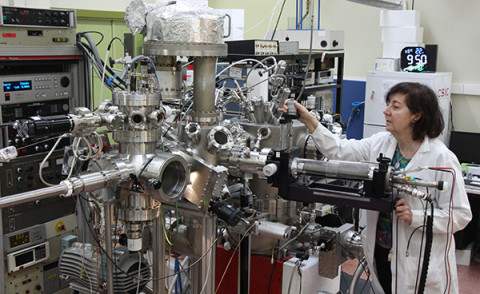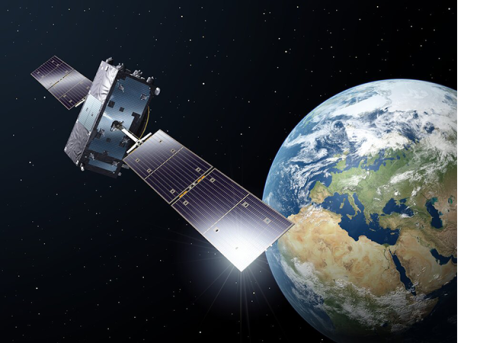ICMM-CSIC collaborates with the European Space Agency to protect communication satellites from radiation

The Institute for Materials Science of Madrid (ICMM-CSIC) collaborates with the European Space Agency (ESA) in designing protection for ground communication satellites sent into space. Through simulating space conditions, the laboratory of ICMM-CSIC researcher Isabel Montero studies the development of treatments to preserve the integrity of satellites against electron emissions, reduce corrosion of the aluminum composing most satellites, and protect their radiofrequency devices from potential electron discharges that could hinder communication with Earth.
"What we do in this laboratory is simulate the conditions to which satellites are subjected in space," describes Montero. The scientist recalls that in space, any object is subjected to high-power radiation where there are also free electrons. The combination of solar rays with other energetic electrons produces potential differences of over 10,000 volts, "which can damage or destroy satellite solar panels," explains the physicist.
Outside the satellite, just the Sun's rays alone produce such electron emission (photoemission) that the satellite becomes positively charged: "It's extreme ultraviolet, it doesn't reach Earth because our atmosphere protects us, but satellites are exposed to it," she points out. Satellites are also exposed to other energetic radiations from sources like cosmic rays: "These are electrons so energetic that they become implanted within materials."
To protect communications, ICMM-CSIC leads a contract with ESA that aims to enhance satellite communication capabilities and their lifespan. "We measure electron emission performance to determine discharge thresholds," Montero indicates. In this way, they have developed surface treatments that reduce electron emission "inhibiting discharge to increase operational power."
This isn't the only collaboration between the two institutions: "Regarding the electric charge accumulated on satellite surfaces, we are responsible for measuring the quantum yield of electron photoemission from materials for satellites and characterizing these materials to see how they behave and what they can withstand," describes the research professor. "Simulations are also developed to verify the maximum power that devices onboard satellites can achieve after such radiations," she adds.

ICMM-CSIC is the only European research center performing these measurements for ESA under this recently initiated tender. Indeed, this has maintained the relationship between both institutions for over two decades. Montero also reveals that her laboratory is developing innovative treatments to reduce secondary electron emission in space devices, "to prevent their multiplication in avalanche," she details.
New protection formulas
These low electron emission surface treatments are carried out in silver using liquid-phase methods. "These are the most interesting for use in the space industry, as opposed to other treatments that require a vacuum," explains Montero. "We have an international patent with ESA and Airbus Germany (a global leader in the aerospace sector), which is extended to the United States and Canada," enumerates the researcher, who currently also collaborates with Thales Alenia Space (the largest European satellite manufacturer) and ESA in exploring improvements to these coatings for the Galileo system (the Global Satellite Navigation System). The goal is to increase the power of radiofrequency devices onboard satellites: they need to protect these devices from potential electron discharges that would hinder communication with Earth and thus could jeopardize space missions.
"In that project, we also have to find innovative corrosion protection treatments for aluminum alloys," she adds. Satellites need to be made from various lightweight materials, hence the choice of aluminum alloys, which will require corrosion protection. "Since chromium VI treatment has been definitively banned as it is considered carcinogenic, we have to look for another corrosion protection treatment, and this has significant economic relevance worldwide," defends Montero, who recalls that the Ministry of Science, Innovation, and Universities "is crucial in these research efforts."
In space, many dangers threaten anyone daring to venture outside, and one of the most dangerous charged particles is atomic oxygen, as it is corrosive. Efforts to assess their damages and protect against them continue, and this laboratory is also involved, having received a request from ESA to perform secondary emission measurements of materials before and after being impacted by these particles. "They do the treatment and send it to us to measure the results; it's a testament to the trust they place in ICMM-CSIC," concludes the scientist.
Instituto de Ciencia de Materiales de Madrid (ICMM)
Sor Juana Ines de la Cruz, 3
Cantoblanco, 28049
Madrid, España
Telephone: (+34) 91 334 90 00
Email: @email
Communication Office: @email

Acknowledge the Severo Ochoa Centres of Excellence program through Grant CEX2024-001445-S/ financiado por MICIU/AEI / 10.13039/501100011033

Contacto | Accesibilidad | Aviso legal | Política de Cookies | Protección de datos